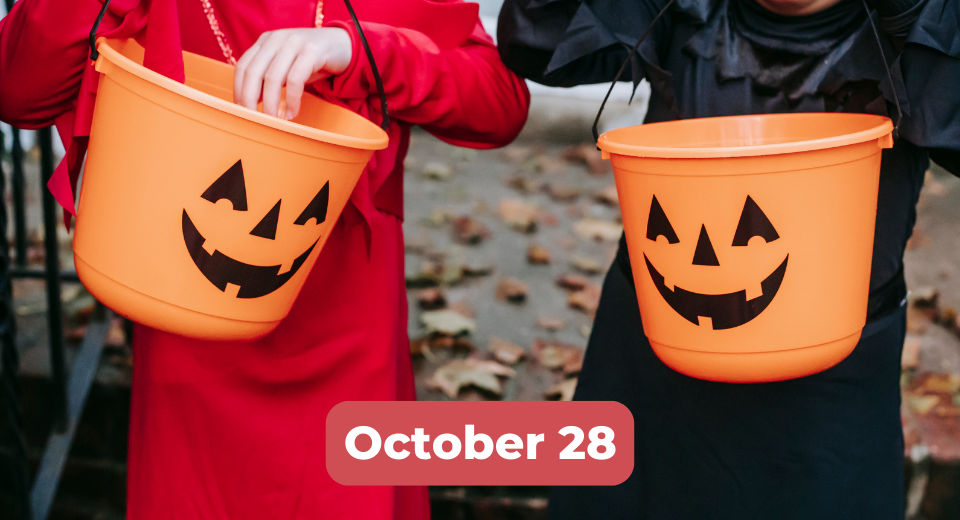
Author: Dr. Colleen Kraft, Pediatrician
After COVID-19 canceled or restricted years of Halloween celebrations, this year you may want to go big on holiday festivities. Halloween parties are probably back on your calendar, as well as trick-or-treating, checking out spooky attractions, and visiting pumpkin patches.
It’s okay to indulge, just be mindful of the amount you’re consuming. Eating too many high-sugar foods can lead to obesity and weight gain, which, in turn, can increase the risk of insulin resistance and type 2 diabetes. Even one day of unusually high added sugar intake (like Halloween) may cause a short-term spike in blood sugar [and] insulin levels, which can lead to increased cravings, energy swings, and acute inflammation.
Remember not all sugars are created equal. So how much is too much sugar? If you don’t have any preexisting health conditions, such as diabetes, feel free to snack away on sources of natural sugar. But as for added sugar, the Centers for Disease Control and Prevention (CDC) recommends limiting your intake to less than 10 percent of your total daily calories. That means if you’re following a 2,000-calorie-daily diet, you’d need to cap your added sugar at 200 calories per day, or about 12 teaspoons (tsp). The AHA’s recommendation is even more strict: no more than 9 tsp for men and 6 tsp for women. Having a few pieces of candy along with eating whole fruits and nuts can be a great way to satisfy your desire to eat candy in a balanced way that doesn’t spike future cravings.
Healthier candy options:
1. Snickers – Although Snickers is relatively higher in calories than other candy, it’s recommended to eat a “fun-size” bar because it’s more likely to leave you satisfied, thanks to its filling protein. It also has less sugar than some other candies that are almost entirely pure sugar.
2. Reese’s Peanut Butter Cup – The satisfying combo of protein and a small amount of fiber makes this another good pick. Plus, around the holidays, it’s easy to find single cups (usually they come in a pack of two), so satisfying your sweet tooth in moderation is easier.
3. Peanut M&M’s – It’s got peanuts, which means you’ll get protein, fiber, and good fats, which help prevent blood sugar spikes and overindulging.
4. Dark chocolate – Research shows regularly eating a small amount of dark chocolate may help heart health by lowering risk of heart disease and stroke. But again, be sure to enjoy in moderation, as these treats also contain saturated fat, which can instead be harmful to your heart if eaten in excess, according to the American Heart Association.
Here are some safety tips for children this Halloween:
All Dressed Up
- Plan costumes that are bright and reflective. Make sure that shoes fit well and that costumes are short enough to prevent tripping, entanglement or contact with flame.
- Consider adding reflective tape or striping to costumes and Trick-or-Treat bags for greater visibility.
- When shopping for costumes, wigs and accessories look for and purchase those with a label clearly indicating they are flame resistant.
- If a sword, cane, or stick is a part of your child’s costume, make sure it is not sharp or long. A child may be easily hurt by these accessories if he stumbles or trips.
- Review with children how to call 9-1-1 (or their local emergency number) if they ever have an emergency or become lost.
Carving a Niche
- Small children should never carve pumpkins. Children can draw a face with markers. Then parents can do the cutting.
- Consider using a flashlight or glow stick instead of a candle to light your pumpkin.
Home Safe Home:
- To keep homes safe for visiting trick-or-treaters, parents should remove from the porch and front yard anything a child could trip over such as garden hoses, toys, bikes and lawn decorations.
- Parents should check outdoor lights and replace burned-out bulbs.
- Restrain pets so they do not inadvertently jump on or bite a trick-or-treater.
On the Trick-or-Treat Trail:
- If your older children are going alone, plan and review the route that is acceptable to you. Agree on a specific time when they should return home.
- Only go to homes with a porch light on and never enter a home or car for a treat.
- Because pedestrian injuries are the most common injuries to children on Halloween, remind trick-or-treaters:
- Stay in a group and communicate where they will be going.
- Remember reflective tape for costumes and trick-or-treat bags.
- Carry a cell phone for quick communication.
- Remain on well-lit streets and always use the sidewalk.
- If no sidewalk is available, walk at the far edge of the roadway facing traffic.
- Never cut across yards or use alleys.
- Only cross the street as a group in established crosswalks (as recognized by local custom). Never cross between parked cars or out driveways.
- Don’t assume the right of way. Motorists may have trouble seeing trick-or-treaters. Just because one car stops, doesn’t mean others will!
- Law enforcement authorities should be notified immediately of any suspicious or unlawful activity.
Healthy Halloween:
- A good meal prior to parties and trick-or-treating will discourage youngsters from filling up on Halloween treats.
- Wait until children are home to sort and check treats. Though tampering is rare, a responsible adult should closely examine all treats and throw away any spoiled, unwrapped, or suspicious item
However you’re celebrating, the widespread availability of Halloween treats and sweets is one seasonal certainty. BE AWARE of colored “smarty” rainbow looking candy as the DEA has issued a warning that these could be laced with Fentanyl. Please click HERE for more information on this growing crisis.
Please have a happy, healthy, and safe Halloween!
The information
provided is for general interest only and should not be misconstrued as a
diagnosis, prognosis, or treatment recommendation. This information does not in
any way constitute the practice of medicine, or any other health care
profession. Readers are directed to consult their health care provider
regarding their specific health situation. Marque Medical is not liable for any
action taken by a reader based upon this information.


